

An overview of the history of abortion law in the United States, including key state and federal laws and Supreme Court rulings.

By Dr. Carrie N. Baker, J.D.
Chair of American Studies
Professor, Program for the Study of Women and Gender
Smith College
The First Abortion Laws (1820s-1930s)
Social and legal rules governing abortion can be found dating back to the colonial period. In the British colonies, abortion was legal before “quickening,” the point at which a pregnant person feels the fetus move, generally at around four or five months.
Prohibition against abortion didn’t appear in state statutes until the 1820s, and early laws were ambiguous and not strictly enforced. Some laws were poison-control measures, drafted to stem the sale of chemical mixes used to induce abortion.
The history of abortion law is intertwined with racism; slaves were subject to the rule of their owners, who generally wanted their enslaved captives to produce as many children as possible. To this day, Black women and other women of color often experience additional hardships concerning access to abortion.

By the late 19th century, most states had laws in place restricting abortion. This was part of a backlash against the growing women’s rights movement, which advocated for “voluntary motherhood.” Even though the movement did not support abortion, the demand for birth control was seen as a threat to male dominance; restricting abortion became part of an effort to control women and confine them to a traditional childbearing role.
It also was a way for men in the newly established medical profession to take control over the highly profitable business of childbirth from midwives, whom they condemned for performing abortions.
Additionally, attacks on abortion access were rooted in racism and white supremacy. The eugenics movement stoked fears about the loss of white identity. In the late 1800s, increased immigration, specifically of Catholic immigrants, and the declining birthrate among U.S.-born white Protestant women, drove efforts to criminalize abortion. White doctors often targeted Black midwives for particular condemnation.
Despite legal prohibitions, abortions continued surreptitiously into the 20th century.
The Toll of Illegal Abortions
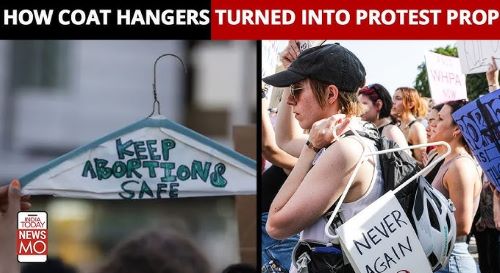
While there were some providers who performed abortions despite its illegality, finding one often depended upon your finances, your race, and where you lived. Women with money could sometimes find a physician in the United States who would perform the procedure for a high fee. By the mid-20th century, some women traveled abroad to obtain an abortion. Those without funds, especially women of color, suffered disproportionately. They were often at the mercy of incompetent practitioners with questionable motives or forced to resort to dangerous self-abortions.
In desperation, some women inserted knitting needles or coat hangers into their vaginas and uteruses, douched with solutions such as lye, or ingested strong drugs or chemicals. Because many deaths were not officially attributed to unsafe, illegal abortion, it’s impossible to know the exact number of lives lost. However, we do know that thousands of women a year were treated for health complications due to botched, unsanitary, or self-induced abortions, and many died. Others were left infertile or with chronic illness and pain.
Hospitals had entire wards dedicated to caring for women suffering from health complications, most of whom had tried to induce their own abortion or had had an illegal abortion. In 1939, Cook County Hospital, Chicago’s public hospital, reported treating more than 1,000 women annually. That number increased to nearly 5,000 in 1962.
In 1972 I was a third-year medical student doing my first clinical experience in obstetrics and gynecology…. At that time, Cook County had a 40-bed Septic Abortion Ward. It was a large room with the beds separated by curtains. The role of the medical student — my role for the week I was there — was to push a large cart of antibiotic solutions around the room, hang the antibiotics and connect them to the IV line, and take the patients’ vital signs. When one of the patients died, I was to call the diener — the morgue attendant who collected the bodies. A death in this ward was a common occurrence.
Making Illegal Abortion Safer

Wherever abortion is illegal, caring and dedicated people take enormous risks to provide safe abortions clandestinely, to treat people who have complications, and to help them find safe providers.
Before the Supreme Court’s landmark Roe v. Wade decision that legalized abortion in 1973, some well-trained physicians and other medical practitioners risked imprisonment, fines, and loss of their medical licenses to provide abortions. Information about these services often spread by word of mouth.
In the late 1960s, the Clergy Consultation Service on Abortion — a network of concerned pastors and rabbis — set up referral services to help women find safe illegal abortions. Early second wave feminist groups formed their own independent referral groups.
In Chicago, a group of trained laywomen called the Abortion Counseling Service of the Chicago Women’s Liberation Union went even further, creating an underground feminist abortion service in 1969. The group, whose code name was Jane, provided safe, inexpensive, and supportive illegal abortions.
Over a four-year period, the group provided more than 11,000 first- and second-trimester abortions with a safety record comparable to that of today’s legal medical facilities.
Laura Kaplan, a former Jane member and the author of The Story of Jane: The Legendary Underground Feminist Abortion Service, describes the women involved:
“We were ordinary women who, working together, accomplished something extraordinary. Our actions, which we saw as potentially transforming for other women, changed us, too. By taking responsibility, we became responsible. Most of us grew stronger, more self-assured, confident in our own abilities. In picking up the tools of our own liberation, in our case medical instruments, we broke a powerful taboo. That act was terrifying, but it was also exhilarating. We ourselves felt exactly the same powerfulness that we wanted other women to feel.”
Organizing to Change the Law
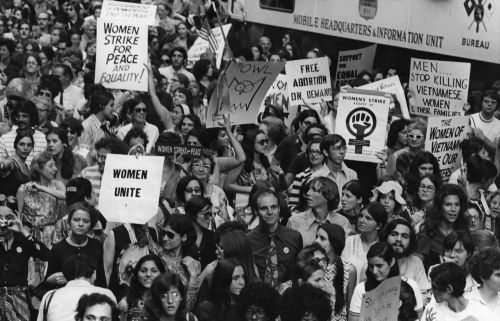
In the 1960s, inspired by the civil rights and antiwar movements, women organized a women’s liberation movement. Reproductive rights were among their highest priorities.
Advocates marched and lobbied to make abortion safe and legal. At speak-outs, women talked publicly for the first time about their illegal abortion experiences, making visible the millions of people who were willing to break the law and risk their lives to obtain an abortion, or help someone else do so. The movement also connected abortion rights to gender equality.
When I was 15 and pregnant, abortion was illegal. I was denied any choice—I had a baby that I gave up for adoption. This experience has been a driving force in my life. I became an OB/GYN; I do abortions because I am totally committed to making sure that other women have the options that I didn’t have.
Between 1967 and 1973, 14 states modified and four states repealed restrictive abortion laws. Changes included allowing access to abortion in certain circumstances, such as when the pregnancy was the result of rape or incest.
In 1967, Colorado was the first U.S. state to decriminalize abortion, although it was only allowed in cases of rape, incest, or when the pregnancy would cause “permanent physical disability” to the woman. In 1970, New York became the first state to legalize abortion on demand through the 24th week of pregnancy. Hawaii had earlier legalized abortion through 20 weeks, but only for residents of that state, and Washington, D.C., also allowed abortions. Two other states, Alaska and Washington, followed. During this period, women who could afford it began traveling to places where it was legal to get abortions.
Feminist networks offered support, loans, and referrals and fought to keep prices down. But for every person who managed to get to New York or the few other places where abortion was legal, many others with limited financial resources or mobility still sought illegal abortions.
‘Roe v. Wade’: A Milestone Decision

On January 22, 1973, the U.S. Supreme Court struck down all existing criminal abortion laws in the landmark Roe v. Wade decision. The Court ruled that people have a fundamental “right of privacy … founded in the Fourteenth Amendment’s concept of personal liberty.”
The Court weighed a pregnant person’s right to privacy against the state interests in supporting maternal health and fetal life. The Court held that the abortion decision must be left to the person carrying the pregnancy, in consultation with their doctor, during the first trimester; the state may regulate abortion in ways that are reasonably related to maternal health in the second trimester; and the state may regulate or prohibit abortion in the third trimester, except where necessary to preserve the person’s life or health.
Weakening the Constitutional Protection for Abortion
Overview
While many were thrilled and relieved that abortion was now legal across the country, others were appalled and turned to state legislatures to restrict access. During this period, abortion became a partisan issue. The Republican party adopted an anti-abortion position, whereas the Democratic party supported abortion rights. While Southern Baptists initially supported abortion rights established in Roe v. Wade, soon abortion became a major wedge issue for the rising tide of white evangelical Christians, who mobilized to restrict abortion access and aligned politically with the Republican party. This change in rhetoric and policy has been traced to their need for a successful uniting issue after their support for racial segregation became unviable as a wedge issue.
From 1973 until 1992, restrictions on abortion were passed in almost every state. Abortion rights activists appealed, but the Supreme Court rejected hearing most of these cases. However, during this time period the Court handed down several major rulings that made it more difficult for young people and those with limited funds to access abortion.
Bellotti v. Baird and Parental Consent
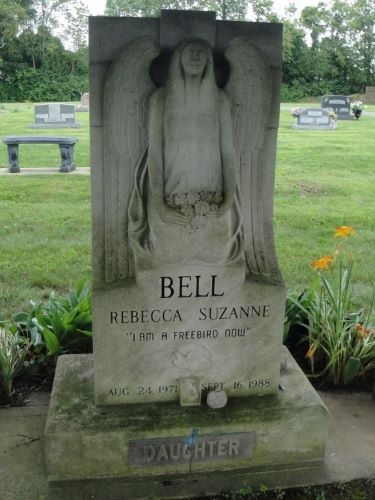
In Bellotti v. Baird (1979), the Supreme Court ruled that states could insist that a minor obtain parental consent to obtain an abortion. The Court, however, required that states provide a judicial bypass option, whereby young people could petition a judge for permission to obtain an abortion without notifying their parents – if they could show that they were mature enough to make their own decision or that the abortion was in their best interests.
Rebecca Suzanne “Becky” Bell was the first person known to die of an illegal abortion because of parental consent laws. On September 16, 1988, the 17-year-old Indiana teenager died of complications from a septic abortion after becoming discouraged from obtaining a legal procedure because of Indiana’s parental consent law.
Hyde Amendment and Medicaid Funding
The Supreme Court also allowed Congress to block Medicaid funding for abortion. When Roe v. Wade legalized abortion, Medicaid — a healthcare program funded jointly by the federal government and individual states — covered abortion care as part of comprehensive health care services provided to low-income women.
But in 1976, Congress passed the Hyde Amendment, which banned the use of federal funding for abortion care, except in limited cases. Most states followed, instituting bans in their state Medicaid programs.
Because so many women depend upon Medicaid for their health care, the Hyde Amendment effectively made it much more difficult for low-income women — disproportionately women of color — to get abortions.
On October 3, 1977, a young mother named Rosie Jiménez, pursuing a nursing degree to support herself and her daughter, died after having an abortion in Mexico because Medicaid would not cover the cost of abortion in the United States. She was the first known victim of the Hyde Amendment.
In 1980, in Harris v. McRae, the Supreme Court upheld Hyde in a narrowly divided ruling, stating that women’s constitutional rights were not violated by the ban on federal funding for abortions, even if the abortion is medically necessary for a person’s health.
Planned Parenthood v. Casey: A New Legal Test

The next major Supreme Court ruling regarding abortion access came in 1992, when the Court, in Planned Parenthood v. Casey, considered a highly restrictive Pennsylvania law that required a 24-hour waiting period, spousal notification, parental consent, a mandate that doctors give biased counseling to people seeking abortion health care, and burdensome reporting requirements.
In its decision, the Court abandoned the trimester framework and created a new legal test for allowable restrictions.
Before viability — which is the point at which a fetus can survive outside the womb, somewhere between 24 and 28 weeks — the Court allowed restrictions on abortion, as long as the law does not place an “undue burden” on a person’s access to abortion. The Court defined an “undue burden” as a restriction that has the “purpose or effect of placing a substantial obstacle in the path of a woman seeking an abortion.”
Under this new standard, the Court upheld all of the Pennsylvania restrictions except for spousal notification, which it noted could place women in danger from abusive husbands.
The Court allowed states to ban abortion after viability, as long as they had an exception to preserve the life or health of the pregnant person.
Sternbeg v. Carhart and Second-Trimester Abortions
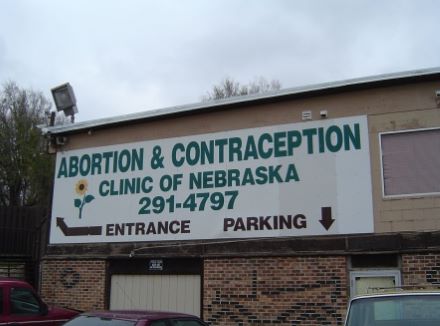
In the aftermath of Casey, state and local legislatures began to pass more and more laws to restrict abortion, and the Supreme Court more often upheld them.
In the 2000 case of Stenberg v. Carhart, the Supreme Court struck down a Nebraska statute prohibiting what anti-abortion advocates called “partial birth abortion.” Although the term does not refer to any medical procedure, the law was interpreted as prohibiting doctors from performing an intact dilation and extraction abortion, a procedure sometimes used for second trimester abortions.
The Court held that if a particular abortion method may be safer in some circumstances, the state cannot flatly ban the method and must allow a maternal health exception.
Anti-abortion rights advocates deliberately used “partial-birth abortion” to confuse the public and build support for restrictions. Three years later, Congress passed a nearly identical law, the Partial-Birth Abortion (PBA) Ban Act of 2003, which was signed into law by President George W. Bush.
Gonzales v. Carhart Changes Course
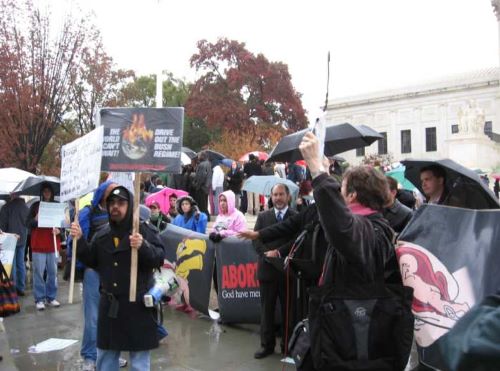
Abortion rights advocates once again challenged the law, but this time the Supreme Court had two new conservative appointees: Justice John Roberts joined the Court in 2005, and Justice Samuel Alito in 2006. As a result, the Court overruled Stenberg v. Carhart and upheld the abortion ban in the 2007 case of Gonzales v. Carhart.
This law is one of many instances of politicians dictating the practice of medicine without regard for medical science or a pregnant person’s health. It also highlights the increasing politicization of the Supreme Court: A candidate’s position on abortion – specifically, being anti-abortion – had become a litmus test for Republican presidents.
In her dissent to Gonzales v. Carhart, Supreme Court Justice Ruth Bader Ginsburg criticized the ruling, saying:
Today’s decision is alarming … It tolerates, indeed applauds, federal intervention to ban nationwide a procedure found necessary and proper in certain cases by the American College of Obstetricians and Gynecologists (ACOG). It blurs the line, firmly drawn in Casey, between previability and postviability abortions. And, for the first time since Roe, the Court blesses a prohibition with no exception safeguarding a woman’s health.
The Rise of State Restrictions
Overview
According to Guttmacher Institute, since the 1973 Roe v. Wade decision, states have passed more than 1,300 abortion restrictions (as of 2021). These laws ban abortion after a particular gestational age or based on sex, race, or genetic anomaly, ban specific abortion methods, impose biased counseling and waiting periods, require unnecessary ultrasounds, restrict access to medication abortions, limit who can provide abortion health care, and impose targeted regulation of abortion providers, or TRAP, regulations.
The constant onslaught of anti-abortion rights measures endangers women’s health and forces reproductive rights and justice activists to challenge each restriction and fight the same battles repeatedly.
TRAP Regulations Take Hold
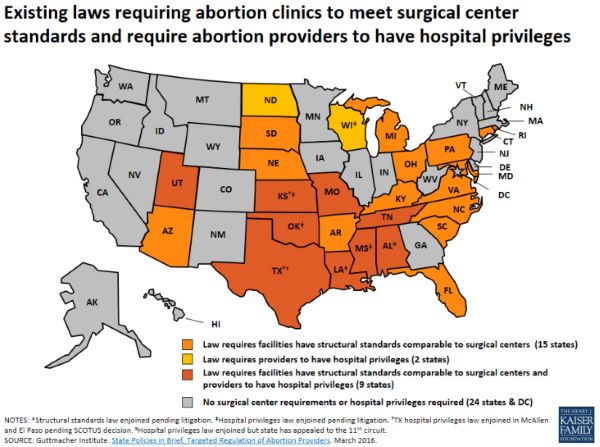
TRAP (Targeted Regulations of Abortion Providers) regulations refer to burdensome and medically unnecessary requirements that are more stringent than requirements for other medical procedures of similar risk.
For example, TRAP laws sometimes mandate the width of hallway corridors in abortion facilities — forcing clinics to close if they can’t afford expensive renovation costs — or require physicians to obtain admitting privileges at a nearby hospital — when no nearby hospital is willing to grant them, due to religious affiliation or refusal to involve itself in a politically charged issue.
Anti-abortion rights activists claim the requirements make abortion safer, but there is no evidence that this is true. To be clear, abortion is one of the safest medical procedures in the country, far safer than pregnancy and childbirth, and complications are rare.
The true intent of TRAP laws is not to improve the safety of abortion but to place expensive and complex rules on clinics and abortion providers so that they have to shut down. According to Guttmacher Institute, as of early 2022, 23 states had TRAP laws or policies in place.
Whole Woman’s Health v. Hellerstedt: Challenging TRAP Laws
In 2016, a TRAP law challenge finally reached the Supreme Court in the case of Whole Woman’s Health v. Hellerstedt (2016). The case involved a Texas law that 1) required physicians who perform abortions to have admitting privileges at a nearby hospital; and (2) required abortion clinics in the state to have facilities comparable to an ambulatory surgical center – which usually means a freestanding surgery center with an operating room.
The Court ruled that these restrictions violated the 14th Amendment because they imposed an undue burden on abortion access. The Court said that reviewing courts must “consider the burdens a law imposes on abortion access together with the benefits those laws confer,” and that courts retain “an independent constitutional duty to review factual findings where constitutional rights are at stake.”
Texas tried to justify the restrictions on the grounds of protecting women’s health, but evidence in the record proved that the provisions provided no medical benefit and in fact endangered women’s health.
Personhood Laws
Anti-reproductive rights activists use the concept of “personhood” to attempt to pass laws that define zygotes, embryos, and fetuses as “persons” separate from the pregnant person, and with the full legal rights as a person.
The goal of personhood laws is to criminalize abortion as well as certain forms of birth control that work by preventing sperm from fertilizing an egg. Opponents of abortion rights have even used proposed measures to prevent doctors from treating complicated and potentially dangerous pregnancies.
Many state legislatures have considered legislation with personhood language, and several have passed them, including Alabama, Kansas and Missouri.
Protection of Patients and Providers
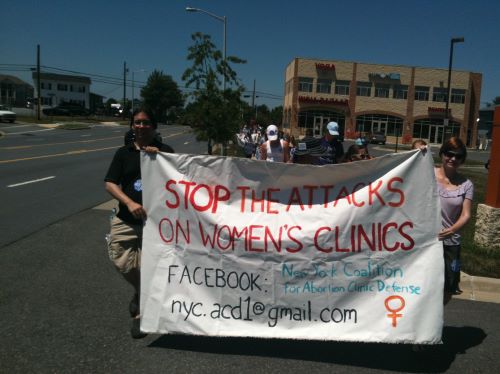
For decades, the anti-abortion rights movement has waged a widespread campaign of harassment, violence and terror against doctors who provide abortions, their staff, clinics and patients. Tactics have included blockades of clinic entrances, facility invasions, property damage, stalking, death threats, and physical violence.
According to a 2022 report by the National Abortion Federation, anti-abortion extremists have murdered 11 people since 1977, while patients, providers and volunteers have been subjected to 42 bombings, 196 cases of arson, 491 assaults, and thousands of incidents of criminal activities.
When this violence escalated in the early 1990s, a Democratic Congress passed the Freedom of Access to Clinic Entrances Act of 1994, which prohibits intentional property damage and the use of “force or threat of force or … physical obstruction” to “injure, intimidate or interfere with” someone entering a health care facility.
Several states have passed laws to protect patients, providers, and clinics from anti-abortion extremists. As of 2021, 14 states had laws to protect access to clinics, including laws prohibiting blocking an entrance; threatening or intimidating staff or patients; damaging a facility; making harassing phone calls; creating excessive noise outside a clinic; possessing and/or having access to a weapon during a demonstration at a facility; trespassing; or releasing a substance that produces noxious odor on clinic premises.
Several states have laws creating a buffer zone around clinics, or a “bubble zone” around a person within a specific distance of a clinic’s entrance or driveway. In the 2000 decision Hill v. Colorado, the Supreme Court upheld a floating 8-foot “bubble zone” law in Colorado, but in the 2014 case of McCullen v. Coakley, the Court struck down a Massachusetts law that placed a 35-foot buffer zone around clinic entrances.
Despite these protections, many clinics that provide abortion care still report experiencing threats and intimidation against doctors and staff.
Abortion and the Affordable Care Act
Prohibitions or restrictions on abortion coverage are not limited only to statutes governing public funding. In 2010, the Affordable Care Act (ACA) was signed into law, extending the Hyde Amendment restrictions on abortion coverage to states’ newly created health insurance exchanges.
The ACA allows states to prohibit abortion coverage entirely in health insurance plans offered through an exchange. Since the law was implemented, multiple states have barred health plans from covering abortion. The ACA also permits providers and facilities to refuse to provide, pay, or refer for abortion services under federal refusal provisions. As of 2021, 46 states had similar laws.
Abortion advocates continue to fight the Affordable Care Act’s restrictions on abortion coverage. These restrictions force some people to continue pregnancies they do not want and may put their health or lives at risk.
As more states attempt to limit or ban private insurance coverage for abortion services, organizations including the Center for Reproductive Rights and Guttmacher Institute are pushing to ensure coverage for all pregnancy-related care, including abortion, under the ACA.
Restrictions on Funding Abortion
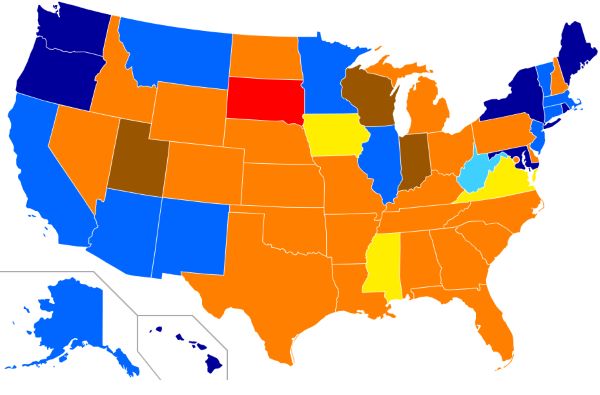

In addition to restrictive state laws, the federal Hyde Amendment and subsequent federal and state laws banning public funding for abortion continue to limit access for people with low incomes, who are disproportionately women of color.
Currently, Medicaid covers abortion only in cases of rape, incest, or when the pregnant person’s life is endangered by an illness, injury, or physical disorder. In May of 2021, President Joe Biden, for the first time ever, proposed a federal budget without the Hyde Amendment, but the Hyde Amendment was restored and passed in March of 2022.
While the Hyde Amendment restricts state Medicaid programs from using federal funds to cover abortion outside the above circumstances, states can use their own funds to cover abortion.
In 2022, 16 states fund abortion services on the same terms as other pregnancy-related health services, which means these states use their own funds to cover abortions, in addition to what the Hyde Amendment allows.
Thirty-three states and the District of Columbia follow the federal standard and only provide abortions in the circumstances outlined in the Hyde Amendment. As of 2018, over half of reproductive age women on Medicaid — more than 7 million women — lived in states that restrict abortion coverage.
The Hyde amendment and its progeny have expanded in scope and currently also limit federal funding of abortion services for federal employees, women in the military and Peace Corps, American Indian and Alaskan native women who use the Indian Health Service, and women in federal prisons and immigration detention facilities.
Under the leadership of women of color organizations and their allies, activists are attempting to repeal Hyde and restore public funding for abortion health care.
Gag Rules
Global
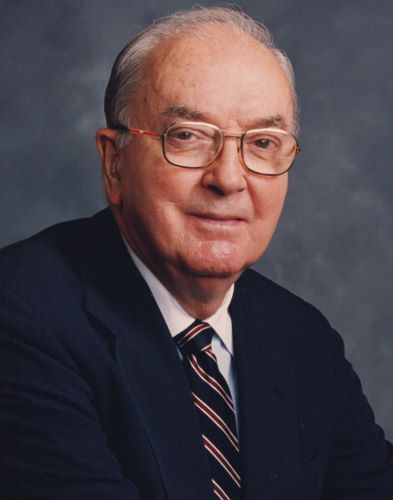
Congress has also blocked foreign aid from covering or even providing information on abortion health care. The Helms Amendment — first passed in 1973 and named after the late ultra-conservative Senator Jesse Helms (R-N.C.) — bars the use of U.S. foreign aid funds to support abortion care.
In 1984, Ronald Reagan instituted the Mexico City Policy, which came to be known as the “global gag rule.” Under this rule, foreign nongovernmental organizations are not allowed to receive U.S. family planning funding unless they agree to stop providing abortion-related services or advocating for the expansion of abortion access, using any source of their funding.
The global gag rule has been in place under Republican presidents since 1984, and repealed by every Democratic president. In 2017, Donald Trump expanded the global gag rule to apply to all U.S. global health assistance. President Biden rescinded the global gag rule when he took office in January 2021.
Some members of Congress have fought against these global restrictions on abortion care. In 2019, Sen. Jeanne Shaheen (D-NH) and Rep. Nita Lowey (D-NY) introduced the Global Health, Empowerment and Rights (HER) Act, which would repeal the global gag rule. And in 2020, Rep. Jan Schakowksy (D-Ill.) introduced the Abortion is Health Care Everywhere Act of 2020, the first-ever legislation to repeal the Helms Amendment.
Domestic
In March 2019, the Trump administration enacted a domestic gag rule, which prohibits U.S. clinics receiving Title X family planning funds from referring their patients for abortion health care.
For decades, Title X clinics have provided free or low-cost reproductive health care. The domestic gag rule devastated the Title X network’s capacity, cutting it by half. President Biden reversed the domestic gag rule in November of 2021.
To strengthen abortion rights more broadly, advocates are now pushing for the Women’s Health Protection Act, which would prohibit a range of abortion restrictions, including previability bans, state mandates of unnecessary procedures and inaccurate counseling, barriers to telemedicine abortion, TRAP laws, and forcing extra in-person visits to a doctor.
Supreme Court Changes during the Trump Administration
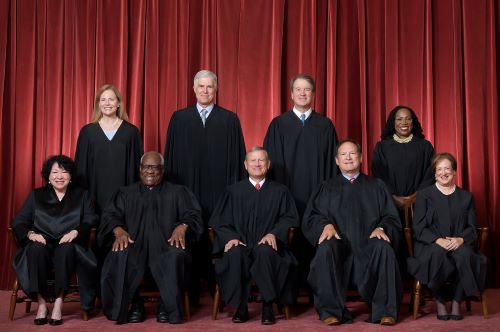
After Donald Trump became president in 2017, he appointed two new ultra-conservative justices to the Supreme Court — Neil Gorsuch and Brett Kavanaugh — emboldening anti-abortion rights activists, policymakers, and right wing, antifeminist judges.
The appointments also emboldened state legislatures. In the first five months of 2019, seven states under Republican control passed bans on first-trimester abortions.
Georgia, Kentucky, Louisiana, Mississippi and Ohio adopted so-called “fetal heartbeat” bills that prohibit abortions after six weeks of pregnancy. Fetuses do not yet have hearts at six weeks of gestation, but six weeks is usually when doctors can start detecting embryonic cardiac activity via ultrasound. Missouri passed an eight-week ban. Alabama voted to ban all abortions except to save a pregnant person’s life, with no exception for rape or incest.
Despite the 2016 Whole Woman’s Health decision, the Fifth Circuit Court of Appeals upheld an identical admitting privileges law in Louisiana, purporting to distinguish the effects of the law from the Texas law at issue in Whole Woman’s Health.
In June of 2020, the Supreme Court narrowly ruled in June Medical Services v. Russo that the Louisiana law was unconstitutional. Chief Justice Roberts, who had dissented in Whole Woman’s Health, concurred in the judgment to provide a fifth vote striking down the Louisiana law.
In his opinion, Roberts criticized Whole Woman’s Health and suggested ways to narrow the undue burden standard in future cases, but he concurred on the grounds of respect for precedent. In doing so, he created a blueprint for states to restrict abortion, and in August 2020, Arkansas enacted four new restrictions.
One of these, a ban on dilation and extraction procedures, prevents the most common method of providing second-trimester abortion care. Another requires that abortion providers notify law enforcement officials when a patient 17 years old or younger seeks an abortion.
Supreme Court’s Lurch to the Right Sparks More State Bans
Shortly before the 2020 presidential election, staunch feminist Supreme Court Justice Ruth Bader Ginsburg died. Despite the imminent election he would soon lose, Donald Trump nominated fundamentalist anti-abortion advocate Amy Coney Barrett to fill Ginsburg’s seat.
The Republican Senate leadership confirmed Barrett’s nomination in record time, tilting the balance of the court to a 6-3 hard right supermajority with the three Trump appointees.
In response to this shift, Republican states quickly began passing anti-abortion laws. According to Guttmacher Institute, states enacted 108 abortion restrictions in 2021, far surpassing the previous post-Roe record of 89 set in 2011.
In May 2021, Texas passed a six-week abortion ban — called S.B. 8 — with a private enforcement scheme that attempts to circumvent federal court review. S.B. 8 allows private citizens to file civil lawsuits against anyone who knowingly “aids or abets” an abortion. People receiving abortion care are exempt, but a wide range of others can be sued, including abortion providers and clinic staff, friends and family who help the pregnant person with advice or funds, and drivers who take people to their appointments. The law tells the courts to award plaintiffs at least $10,000 in damages from defendants.
Abortion providers challenged the law, but the Supreme Court allowed the ban to go into effect on September 1, 2021, despite the fact that the law clearly violated Roe.
‘Dobbs v. Jackson Women’s Health Organization’: Overturning Roe
On June 24, 2022, the United States Supreme Court ended constitutional protections for the right to abortion. The sweeping decision in Dobbs v. Jackson Women’s Health Organization overturned the longstanding precedents of Roe v. Wade (1973) and Planned Parenthood v. Casey (1992). For the first time in the history of the Supreme Court and the United States, a fundamental constitutional right was taken away.
Guttmacher Institute predicted that in the absence of Roe, 26 states would be certain or likely to ban abortion. These abortion bans will cover much of the South and Midwest of the United States. At the time of Dobbs, thirteen states had “trigger laws” to ban abortion shortly after Roe’s reversal, including Arkansas, Idaho, Kentucky, Louisiana, Mississippi, Missouri, North Dakota, Oklahoma, South Dakota, Tennessee, Texas, Utah and Wyoming. Many states ban abortion from the moment of fertilization and others ban abortion between six and 15 weeks of pregnancy. Eleven states have no exceptions for rape or incest. Six states have no exceptions for the health of the pregnant woman. Even when there are life or health exceptions to these abortion bans, pregnant women experience significant hurdles to accessing abortion health care.
Donald Trump’s three Supreme Court nominees—Neil Gorsuch, Brett Kavanaugh and Amy Coney Barrett—joined Clarence Thomas and Samuel Alito, who authored the opinion, to strike down Roe. The Dobbs majority opinion argued that abortion is not a constitutional right because the Constitution does not explicitly mention abortion, the framers of the 14th Amendment in 1868 did not intend to protect the right to abortion, and, finally, that abortion rights are not “deeply rooted in the country’s history and traditions.” The Dobbs opinion focused on mid-19th century abortion prohibitions, but ignores the long history of legal abortion in the United States. Throughout the opinion, the Supreme Court repeatedly refers to embryos and fetuses as “unborn human beings.”
In addition to allowing states to outlaw abortion, the decision puts at risk rights to use in vitro fertilization as well as IUDs and emergency contraception, which many anti-abortion proponents believe—contrary to scientific evidence—cause abortion. The sweeping reasoning of the Court puts at risk a range of privacy-based constitutional rights. In his concurrence, Clarence Thomas calls on the court to revisit the Griswold decision guaranteeing access to contraception and Obergefell, which established the right to enter into a same-sex marriage.
In response to Dobbs, Republican lawmakers and anti-abortion activists from the Susan B. Anthony List announced they were working on legislation to ban abortion nationwide, which they could achieve if Republicans were to win Congress and the White House in 2024. But they may not have to wait that long, because the Court could do that itself. The Dobbs opinion has repeated references to “unborn humans”—23 times—laying the groundwork for striking down state laws protecting abortion rights in states such as California and New York.
People seeking abortion care and those who help them now face criminal prosecution and civil lawsuits in several anti-abortion states. But unlike before Roe, we now live in an era of mass incarceration, which makes it far more likely that women will be surveilled, arrested and jailed.
The New York-based privacy group Surveillance Technology Oversight Project released a chilling report in June of 2022 detailing how anti-abortion governments and private entities are already using cutting-edge digital technologies to surveil women’s search history, location data, messages, online purchases and social media activities by using geofencing, keyword warrants, big data and more.
Even before Dobbs, police and prosecutors were already criminally charging pregnant women for miscarriage, abortion and pregnancy loss, such as Texas woman Lizelle Herrera, who was arrested in April for murder after allegedly causing her miscarriage. Approximately 1,200 women—who are disproportionately low-income women and women of color—have been prosecuted for their behavior during pregnancy over the last 15 years. The National Association of Criminal Defense Lawyers published a report in August of 2021 warning about the threat of increasing criminalization post-Roe.
In addition to surveillance and criminal prosecution, abortion bans will have devastating impacts on the health and well-being of women and their children. Research shows that people denied wanted abortions experience more serious health problems than those having an abortion and are more likely to stay in contact with a violent partner.
They also experience economic hardship and insecurity lasting for years. Women who were unable to obtain an abortion had financial challenges that lasted through the five-year study period. They included a 78 percent increase in unpaid bills and an 81 percent increase in negative credit report notations, like bankruptcies and evictions, compared with the women who were able to get an abortion. Their children were more likely to experience developmental delays and to live in poverty.
While conservative states banned abortion, progressive states such as California, New York and Massachusetts responded to Dobbs by passing laws strengthening abortion rights. As a result, the United States became further divided on access to abortion health, with some states banning abortion and others expanding access to abortion healthcare, particularly in light of a December 2021 FDA policy change on the abortion medication mifepristone, which opened up telemedicine abortion options.
Telemedicine and Medication Abortion
Overview
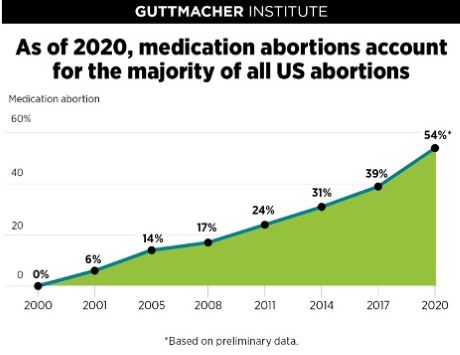
Telemedicine abortion combines medication abortion, which uses pills to end a pregnancy, with telemedicine, which allows health care providers to meet with patients via videoconferencing or telephone consultations.
Medication abortion is a safe way to end an early pregnancy. Approved by the FDA through 10 weeks of pregnancy, medication abortion uses two different medicines: mifepristone, which interrupts the flow of the hormone progesterone that sustains the pregnancy; and misoprostol, which causes contractions. This combination of medications is 95-97 percent effective. Misoprostol alone is also highly effective.
According to Guttmacher Institute, medication abortions account for more than half of all abortions. (The actual rate is likely higher because of the growing number of people who are self-managing their abortions using medication purchased online or obtained in other ways.)
The growth of medication abortion has dovetailed with the expansion of telehealth to provide new opportunities for accessing abortion health care. As abortion restrictions have increased over the last several years, and harassment of people entering health clinics persists, people are increasingly turning to medication abortion and telehealth to increase their safety and privacy when obtaining abortion care.
State and FDA Policy Restrictions on Telemedicine Abortion
Nevertheless, numerous policy barriers limit the reach of telehealth abortion. Many states prohibit patient access to the abortion pill via telemedicine, despite its proven safety.
Currently, 19 states require the prescribing clinician to be physically present when prescribing the abortion pill, while 29 states require the clinician prescribing the abortion pill to be a physician. Neither of these requirements are necessary because the abortion pill is extremely safe and effective.
Another significant barrier to telemedicine abortion until December of 2021 was that the U.S. Food and Drug Administration (FDA) restricted the distribution of mifepristone.
When initially approving the drug in 2000, the FDA, under pressure from anti-abortion forces, blocked easy access to mifepristone, using their Risk Evaluation and Mitigation Strategy (REMS) — a drug safety program that allows the FDA to restrict the circulation of certain medications to help ensure the benefits of the medication outweigh its risks.
Under the REMS program, mifepristone had to be dispensed in person at a clinic, medical office or hospital under the supervision of a healthcare provider registered with the drug manufacturer.
However, between 2016 and 2020, the organization Gynuity Health Projects operated a research study on telemedicine abortion called TelAbortion, which allowed clinicians in 13 states participating in the study to provide medication abortion care by video conference and mail without an in-person visit. This study proved that telemedicine abortion is safe and effective.
In the wake of COVID-19, advocates increasingly challenged the FDA’s REMS restrictions on the abortion pill. This effort was supported by research on the safety of a no-test medication abortion protocol that allows doctors to screen patients by phone or video and then mail abortion pills directly to them.
In March of 2020, a coalition of 21 state attorneys general, led by California Attorney General Xavier Becerra, sent a strongly-worded letter to the U.S. Department of Health and Human Services and its U.S. Food and Drug Administration (FDA), urging the Trump administration to waive or utilize its discretion on enforcement of its REMS designation. Reproductive health groups also pressured the government to remove the REMS restriction on the abortion pill.
That summer, a federal judge in Maryland issued a ruling temporarily suspending enforcement of an FDA restriction on abortion pills during the pandemic. The Trump administration appealed twice to the Supreme Court, which reversed the decision in January of 2021, two months after Trump lost the presidential election.
Under the Biden administration, the FDA reversed course, lifting the in-person distribution requirement on April 12, 2021, for the duration of the pandemic. The Biden administration later announced that the FDA would review the REMS restriction for modification.
In December of 2021, the FDA partially lifted the REMS restriction by removing the long-standing rule that health care providers must distribute the abortion pill mifepristone to patients in person. However, the FDA kept mifepristone within the REMS program, maintaining a requirement that health care providers must register with the drug manufacturer to become certified to prescribe mifepristone. This greatly limits the number of qualified providers.
Another change in the REMS, however, may make it easier for clinicians to prescribe mifepristone: The FDA will allow some pharmacies to distribute the drug. But the FDA is still blocking the abortion pill from being available in pharmacies, like any other drug.
And while the partial removal of the FDA REMS restriction has opened the door to expanded telemedicine abortion access in many states, 19 states still require in-person distribution of the drug.
Support for Self-Managed Abortions
Today, as state and federal laws, insurance changes and clinic closures have made it increasingly difficult to get an abortion, a growing movement is devoted to helping people who are pregnant people learn to self-manage an abortion.
Reproductive health advocacy organizations like Aid Access, Plan C, and SASS provide information and support on how to safely obtain and use abortion pills. Some states have passed laws and supported the prosecution of people who have obtained abortion pills and used them on their own.
The legal advocacy organization If/When/How: Lawyering for Reproductive Justice has a campaign to push for the decriminalizeation of self-managed abortion. If/When/How also provides legal information to people with questions about self-managed abortion and their rights.
Conclusion: Abortion is a Human Right

Access to safe and legal abortion is vital to women’s health and well-being. In 2020, Dr. Diana Greene Foster published the results of an extensive 10-year study, “The Turnaway Study: Ten Years, A Thousand Women, and the Consequences of Having — or Being Denied — an Abortion.” The research provides definitive evidence that access to abortion strongly enhances women’s mental health, physical health, and socioeconomic status. Women who were denied access to abortion and carried an unwanted pregnancy to term were more likely to experience worse outcomes.
International bodies, including the United Nations and the World Health Organization, have recognized abortion and other reproductive rights as human rights under international treaty law. As new generations of activists take on the fight, advocates, activists, and voters will continue to strive for a world where all people have access to safe and legal abortion care.
Originally published by Our Bodies Ourselves Today, Suffolk University, August 2022, republished with permission for educational, non-commercial purposes.






